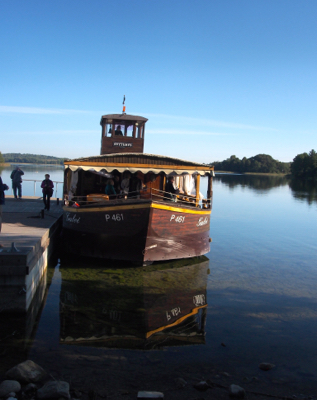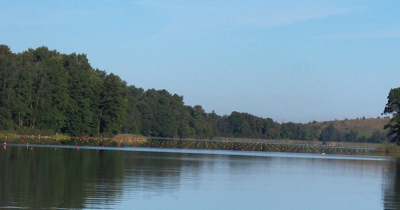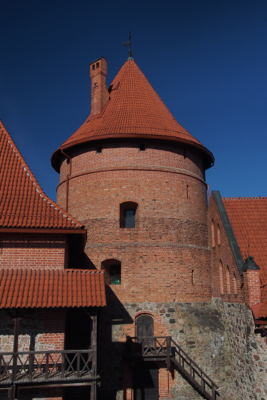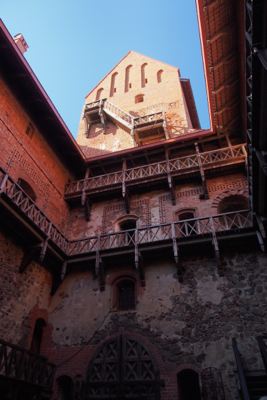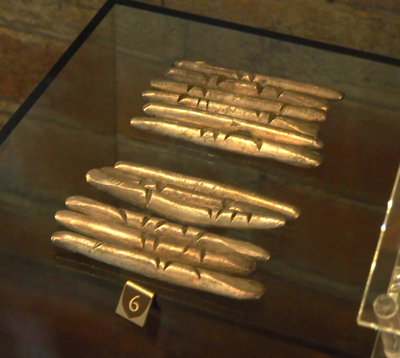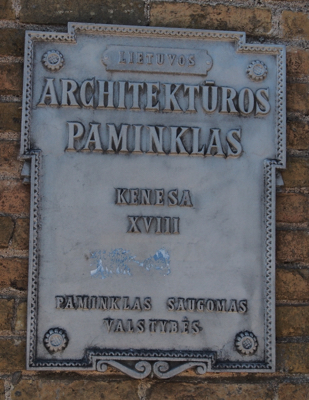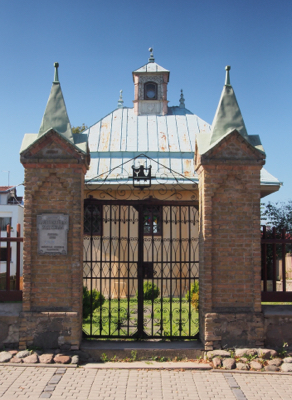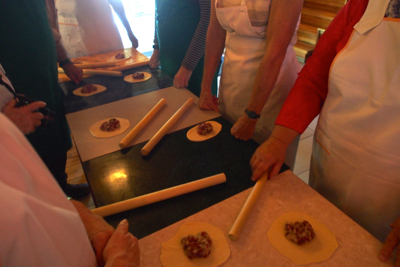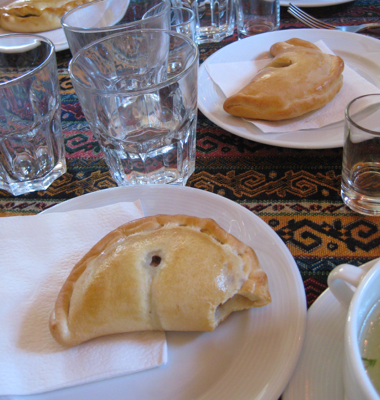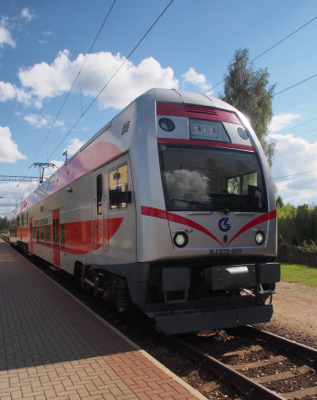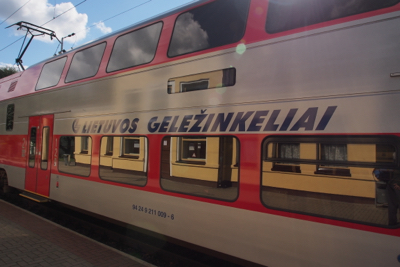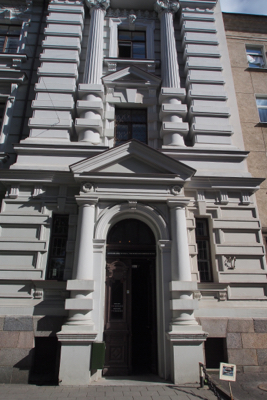Thurs., 9/10/15 – Vilnius, Lithuania
Today we took our motor coach to Trakai, 15 miles outside of Vilnius. Three large lakes surround the town. The Castle at Trakai is on an island in one of the lakes (Lake Galve) and we went over to the castle by boat. From the dock we could see the Lithuanian Rowing Center and the lake is used by sailors and swimmers, especially in July and August.
We toured the castle with Migle as our guide. We entered and stood in the courtyard surrounded by the barracks and stables and defensive walls. Then we walked upstairs and across a dry moat with a drawbridge and entered the ducal palace, completed in 1409. The castle has been restored as a museum.
One room of the duke's residence belonged to his wife and the other to the duke. The duke’s room had three exits: one to the balcony over the courtyard, one to his wife’s room, and the third was an escape route down to his treasury on the ground level. On the other side of the courtyard was the throne room. It is now used for special events and wedding pictures. Originally the throne room had stained glass windows and frescoes on the walls but there were no pictures to enable reproductions. The treasury rooms are now a museum of 1400’s coins, many of which were found in pottery hidden or buried and later discovered. The coins were made of silver and copper. There were no gold coins.
The Grand Dukes of Lithuania used the castle as a summer residence in the 15th c. Vytautas the Great was born and died in this castle in 1430.
Boat on Lake Galve
Lithuanian Rowing Center
Trakai Island Castle
Ducal Palace
Corner tower
Inner courtyard
Treasury room - Lithuanian long currency - used as money by Baltic tribes in the 12th -15th centuries
Form of silver ingots
Lithuania has two small ethnic groups: Karaims and Tatars. Both have Turkish roots and moved here from the Crimea.
When we left the castle and the island by way of a bridge, we walked the street where some Karaims still live. Three hundred families were brought here from Crimea to be bodyguards in the service of the dukes. Today there are only 60 Karaims in Trakai and only 2500 in all of Europe. Only offspring of two Karaim parents can be counted as Karaims so the ethnicity is fading out. The Karaim language is closest to Turkish, their religion is based solely on the Old Testament and the Ten Commandments. They have a prayer house in Trakai and run a summer school for all European Karaims to teach and use their own language.
Sign for Karaite Kenesa (church)
Karaite Kenesa (church)
Karaite Restaurant
Karaite Restaurant sign
We ate lunch at the Karaim restaurant but first had a cooking lesson and made our own Kybyn (kybynlar is plural) or meat pies. We each rolled a ball of dough into an oval shape and closed it over a prepared beef, onion, and cabbage mixture. They were then baked and delivered to our table. Lunch was three kybynlar – one cabbage, one lamb and the one we each made – a salad of pickled Julienne of carrots and beets and a dry nut cake for dessert. We also got to taste their national drink, krupnik. It was a fun experience.
Making Kybyn
Making Kybyn
Kybyn
After lunch, we walked past the souvenir shops/kiosks and our bus took us to the Trakai train station and we rode the new train cars back to Vilnius. It was a comfortable 45-minute ride. Our bus met us in Vilnius and took us to the KGB Museum.
Train from Trakai to Vilnius
Train from Trakai to Vilnius (unpronounceable)
The KGB (Committee for State Security) took over the 1890’s Vilnius courthouse in 1940 and processed political prisoners there. The decisions were short – be killed or sent to a Siberian work camp. The KGB operated there for nearly 50 years. We walked through the prisoner cells and torture rooms. The water cell had a 12 inch round place to stand or the person fell into 18 inches of cold water and then stood and froze over and over till he died. Another room had no place to sleep until the person wrote a confession and then was killed. There was a padded cell with no furniture or light and the execution chamber where prisoners were brought in and shot in the head. It was all very gruesome but very real. Soviet dissidents were killed without any defense. The numbers are staggering. Of the 130,000 Lithuanians deported to Siberia, only 66,000 returned. There are about 3,000 former KGB workers currently living free in Lithuania.
After this sobering experience we walked to a conference room in a nearby restaurant and had a journalist give a lecture on Lithuania today. Of the Soviet counties which regained independence in 1990, only Lithuania, Latvia, and Estonia actively fought for their independence. The Baltic countries cut completely from Russia and now do not even have to rely on Russia for their gas and oil.
Our speaker talked about the EU problem with refugees and migrants. The EU has no plan for what to do with these thousands of people arriving everyday. No one knows how many, from where, and what talents the refugees have. The EU constitution states that once they land in a EU country they must be accepted. They come in, and are given 600 Euros (or 1,000 Euros) as a start in a new country. The EU citizens are not happy that their taxes are being given away to non-citizens. It is a very big problem.
When Lithuania restored its independence they had two major concerns: what to do with communists and what to do with the KGB workers. To the Soviet army they simply said, “Get out!” The Communist and Nazi parties are banned and illegal. Lithuanian collaborators were given a deadline to declare their involvement and then could be repatriated. In most cases there is no remaining proof with which to convict them. Papers and documents were burned by the Soviets.
| Return to Top | Return to Itinerary | Return to Trips page to view other trips | Return to Dreamcatcher Home Page |
